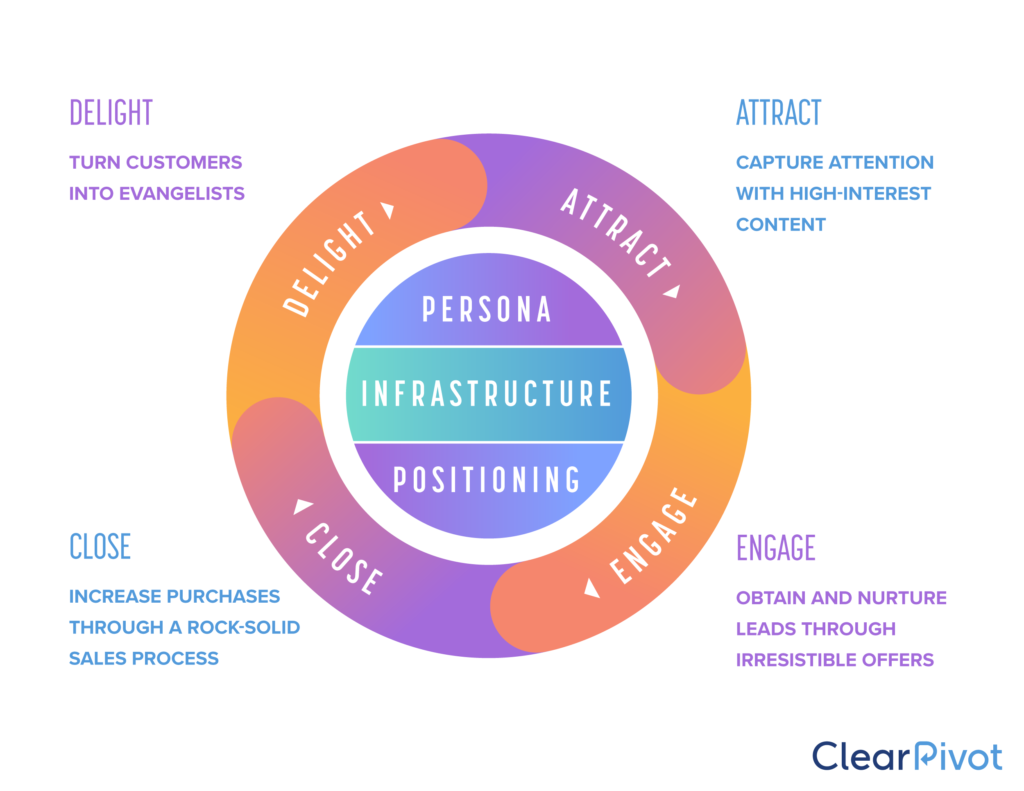The SaaS Marketing Flywheel for Product Marketing
The SaaS Marketing Flywheel for Product Marketing
Product marketing is more than just describing a SaaS product and its features. It’s the glue that holds the inbound marketing flywheel together. The go-to-market strategy, usually overseen by product marketers, provides the underlying structure for attracting, engaging, closing, and delighting customers who will stay with your product long-term. Product marketing can then listen to these customers and analyze their behavior to highlight and educate on the most relevant features of the product. The strategic vision to build relationships and attract long lasting customers relies on all marketing components working together to power the inbound marketing flywheel.
The SaaS marketing flywheel
The inbound marketing flywheel is an update to the old marketing funnel concept. Rather than pouring a lot of potentially unqualified leads into the top, and filtering them out until you have your sales qualified leads toward the bottom, with a percentage of them eventually becoming customers, the flywheel concept is a circular motion that ends up powering itself with centrifugal force.
Let’s go through the basics of each phase of the SaaS marketing flywheel, starting with the core, consisting of personas, positioning and infrastructure.

The flywheel core
At the center of the inbound SaaS marketing flywheel is a core, made up of your buyer personas, market positioning and marketing infrastructure. This core must be in place before you ever try to attract traffic, leads and customers, because it guides your efforts and provides the structure to make them worthwhile. Buyer personas (detailed profiles of your ideal customers) likely come from customer marketing, or the digital team. Whereas the product’s positioning is normally established among other teams, including brand marketing and product marketing. These two core pieces define who you are, and who you’re going after. The marketing infrastructure is the glue holding the core together. It consists of the martech stack as well as the marketing and sales processes you use to operate that tech. With a strong core, the foundation is set for the four stages that revolve around it.
Attract
The first stage of the outer circle of the inbound SaaS marketing flywheel is Attract. This stage is all about drawing people in. Mostly, this means driving traffic to your website, but it can also mean direct app downloads or social media. At the Attract phase, it’s your job to tell a story about the problems you solve and for whom. With a solid SEO strategy, you’ll create blogs and other content to support your mission, and send traffic to your valuable content with ads.
Engage
Once you’ve got the initial attention with your persona-driven content, the next objective is to get more information and nurture your leads into the purchase. Commonly, the Engage phase involves offering high-value content like datasets, white papers or checklists in exchange for a simple form submission that can then be used for lead nurturing.
Close
The Close is the exciting moment when someone says “Yes, I will use your product.” Your job here is to meet them there with a seamless sales process. Tools like lead scoring and message templates can help, and all teams must work together, including marketing and product, not just sales.
Delight
The most invigorating phase for many marketers is the Delight stage of the inbound marketing flywheel, because that’s when we get to surprise and impress our customers. Whether it’s continuing to add (and talk about) new features, a positive ongoing experience with customer support, it pays to treat your customers well, because word of the mouth is what feeds the top of the flywheel again by attracting new, even better leads.
SaaS product marketing for all stages of the inbound marketing flywheel
If the inbound flywheel provides a simple framework for aligned efforts across departmental divisions, teams and subdivisions, each group can contribute more effectively to the holistic result. Specifically, this article focuses on the role and responsibilities of product marketing in each of the 4 stages of the flywheel, each of which has its own set of important tactics.

Attract users with simple, clear product marketing
One of the foundational elements of any SaaS marketing effort has to be the go-to-market plan, including choices on how to sell, and how the product should be positioned. Product marketing’s role in the Attract phase cannot be overstated. The product and its features provide the basis for attracting interested customers in the first place. The way that product marketing decides to talk about and share features and benefits has important implications for the way brand marketers design their messaging and campaigns in the attract phase, especially in terms of product positioning and benefits. In addition, product marketing’s go-to-market strategy determines which channels and pathways all teams will address.
In the Attract phase, SaaS companies use content marketing tactics like pillar page content, blogs, and topic clusters to bring in organic traffic from search, social and review sites. This phase also involves paid efforts like Google Search Ads, social media advertising and affiliate marketing, along with technical SEO and a stellar website experience.
Ahrefs is a powerful SEO SaaS tool with its own powerful organic content strategy. The company’s blog aims to “help you get better at marketing,” and is a stellar example of this beginning of the flywheel Attract phase. Noom, on the other hand, provides an excellent example of paid advertising as it attracts individual users from social platforms like Instagram.
Engage leads with an unforgettable experience
After you’ve got new leads in at the mouth of the inbound marketing flywheel, the next step is to Engage them, and encourage them toward the conversion without selling yet. It’s a nuanced piece of the inbound marketing approach that involves creating a welcoming, informative experience to make your product invaluable – a no brainer to close.
A free trial is your ultimate opportunity to provide this unforgettable experience. Product marketing can contribute to this effort in the Engage phase with tooltips, feature highlights, and customer success examples alongside nurturing efforts from the digital team and customer education initiatives from customer success.
Tradovate is a futures trading platform that offers an all-access two week trial where users can try out all trading features, using up to $50,000 of risk-free simulation. The Chicago-based SaaS company uses automated email campaigns and in-app tooltips to provide a robust trial experience that encourages conversions into their paid subscription and use-based paid versions.
As another example, SaaS platforms like HubSpot even offer robust free versions in perpetuity, and use on-platform opportunities (like showing inactive tools that can be accessed with an upgrade) to encourage free users to convert.
Close leads – directly or indirectly
The Close is where money changes hands. It’s arguably the most important part of the SaaS marketing flywheel, because it’s the phase in which you acquire paying users. Though a sale is the main goal in this phase, the sales team is not the only star of the show. Team members across departments including sales enablement, marketing, sales and the c-suite must be on the same page. In a way, choices made by product marketing lead the planning process here, because the pathway to the sale is determined by the go-to-market plan. Whether your SaaS is sold directly to consumers, or indirectly through channel partners, resellers or affiliates is a planning process led by product marketing. When the right processes are in place to achieve the intended end result, the Close is not just a sales effort.
Having a very clear pricing page like this one from Databox is a crucial part of the Close phase, and in cases where the sales cycle is longer and more involved, a stellar sales team with solid processes is the key to success in the Close.
Delight customers and encourage word of mouth to feed the flywheel
The relationship you have worked so carefully to nurture does not stop when the credit card information is submitted. On the contrary, this is the most crucial opportunity to solidify loyalty and curate a delightful experience that encourages word of mouth. Think of your product onboarding as an extension of product marketing. You’re highlighting the most important features that will make your users fall in love with the solution and keep coming back to use it over and over again. Delighting new customers with clear and easy onboarding is a fast track to retention. Coda.io is one of the most helpful SaaS companies out there, and makes using its cloud based document editor incredibly easy with a detailed knowledge base and free document templates in its doc gallery.
Customer support is another key element of the Delight phase that must not be overlooked. When a new user runs into an issue, they should be able to submit a support ticket at the very least, and even better if they have access to immediate chat or phone support. The decision on how to offer such support depends on your solution’s complexity, and the best way to provide a delightful experience. Squarespace, for example, offers chat support, but intentionally does not provide customer service via phone.
No matter the decision, it is important to delight your users, and encourage them to spread the word. Some SaaS companies offer direct incentives for sharing their solution with friends. One example is Dropbox, which offers the opportunity to earn more storage space for every person referred.
Product marketing holds the inbound flywheel together
For SaaS companies with larger marketing teams, one of the most troubling and unexpected problems can be misalignment between marketing subgroups. Even though the vision for marketing and sales may be unified, somewhere along the way, different priorities evolve in reality, and things can sometimes get disjointed. Different departments, or subgroups in sales and marketing, may include brand marketing, demand generation, lead nurturing, digital marketing, sales enablement, partner marketing, customer marketing, and product marketing. In different organizations, roles may be delineated differently, and of course, many times one department may handle it all.
The key is to make sure everyone is working toward the same unified goal, using messaging that is understandable and aligned. This calibration is much easier with a unifying theory of SaaS marketing, like the inbound marketing flywheel. With a more holistic approach to marketing and sales, subgroups like product marketing can stay connected with the whole picture and find more overall success with SaaS marketing.
Want to learn more? Discover why replacing your marketing funnel with the marketing flywheel puts your customer first.





